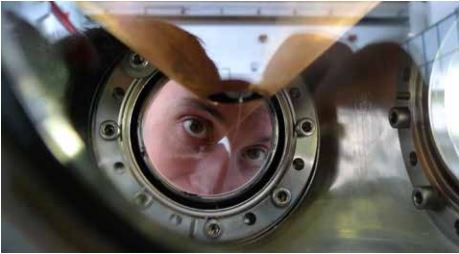In the SBT’s ELISE project about extrusion of solid hydrogen micro-targets for the study of laser/matter interaction, solid hydrogen undergoes very high strains. However, mechanical properties studies of solid hydrogen are very basic; only three studies tackle this question and they are all inconsistent [1]. Thus, it is merely impossible to model the targets production and empirical data are ineffective tools to predict how to produce different geometries or dimensions of targets. That is why we developed a device able to characterise the high deformations of solid hydrogen: APRYL.
This characterisation is fastidious for two main reasons:
1. Solid hydrogen behaviour is somewhat between a soft solid and a highly viscous fluid; studying its deformation comes to studying its flow (i.e. its rheology).
2. Hydrogen solidifies only at very low temperature –below 14 Kelvins at ambient pressure, which involve cryogenics.
APRYL aims to produce a Couette’s flow: a gear wheel immersed into solid hydrogen rotates while we measure the relation between rotation speed and resistive torque. Rotation speed corresponds to shear stress and torque to constraint inside the matter. These measurements are made for several speeds, several torques and several temperatures between 10 K and 14 K. Those data give several rheograms and lead to the apparent viscosity of solid hydrogen. The company Rhéonova worked as consultant in the design of this unique device.
During March 2018, the SBT has made these measurements and a draft of the deformation law could be modelled. This law is consistent with the few data available in scientific literature and broaden the ranges in speed and temperatures. Complementary measurements are undergoing in order to consolidate this law and enhance the model.
This characterisation device has been designed for solid hydrogen, but it could be applied to deuterium or neon. Furthermore this method could be applied for a wide range of solid cryogen (such as helium, nitrogen, oxygen …), even though no other studies has been planned out yet.

A close look at the solid hydrogen ribbon flow from the ELISE nozzle.